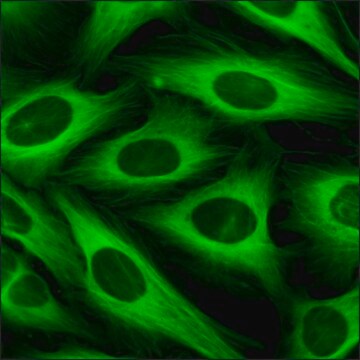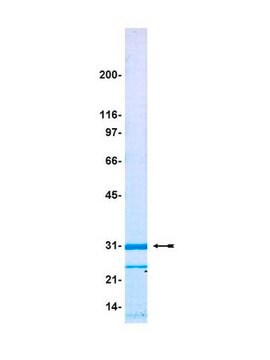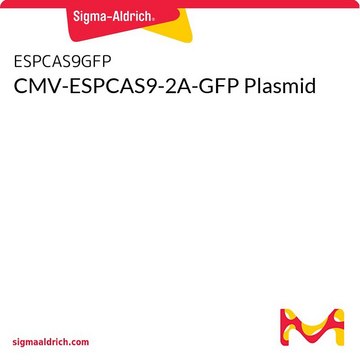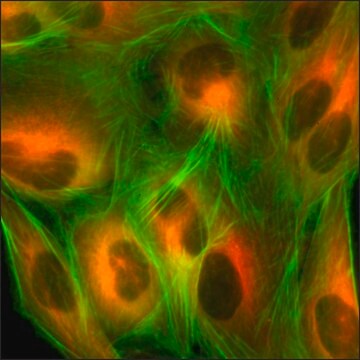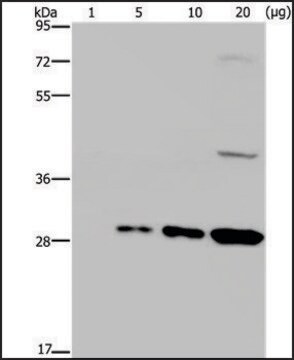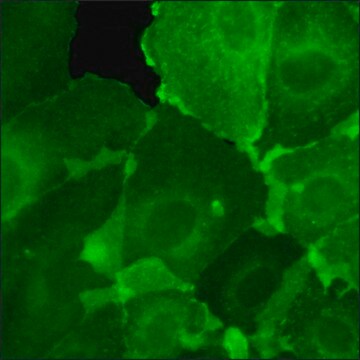CLL1032
U2OS GFP-ACTB
human female bone (Disease source: Osteosarcoma)
Autenticatiper visualizzare i prezzi riservati alla tua organizzazione & contrattuali
About This Item
Codice UNSPSC:
41106514
NACRES:
NA.81
Prodotti consigliati
product name
U2OS GFP-ACTB,
Origine biologica
human female bone (Source Disease: Osteosarcoma)
Livello qualitativo
N° accesso OMIM
Temperatura di conservazione
−196°C
Informazioni sul gene
human ... beta actin(60)
Descrizione generale
This product was derived from ATCC Cat. No. HTB-96.
ACTB (actin beta) gene codes for β-actin. It is a cytoskeletal housekeeping protein. It is present in the cytoplasm. The ACTB gene is located on human chromosome 7p22.1. GFP (green fluorescent protein) is a major reporter protein that has fluorescence properties. It can fluoresce without the help of any cofactors or substrates except for oxygen.
ACTB (actin beta) gene codes for β-actin. It is a cytoskeletal housekeeping protein. It is present in the cytoplasm. The ACTB gene is located on human chromosome 7p22.1. GFP (green fluorescent protein) is a major reporter protein that has fluorescence properties. It can fluoresce without the help of any cofactors or substrates except for oxygen.
U2OS GFP-ACTB are osteosarcoma, epithelial cells, from a human caucasian female (aged 15 years), with a GFP-tagged modification.
Applicazioni
This product is a human U2OS cell line in which the genomic ACTB gene has been endogenously tagged with a Green Fluorescent Protein (GFP) gene using CompoZr® Zinc Finger Nuclease technology. Integration resulted in endogenous expression of the fusion protein in which GFP is attached to the N-terminus of actin. Fluorescence imaging shows that the actin can polymerize to form the characteristic pattern of actin filaments. This stable cell line was expanded from a single clone. The target′s gene regulation and corresponding protein function are preserved in contrast to cell lines with overexpression via an exogenous promoter.
To learn more, please visit the Cellular Reporter Cell Line webpage
Azioni biochim/fisiol
β-Actin modulates cell growth, migration and the G-actin pool. Mutations in ACTB leads to pleiotropic developmental disorder. GFP (green fluorescent protein) is used for quantitative analysis.
Actin β (ACTB) is an abundant cytoskeletal housekeeping protein. The protein, expressed in the nucleus, controls gene expression, cell division and proliferation. ACTB is generally used as a reference gene in measuring expression levels in tumors.
Caratteristiche e vantaggi
GFP-tagged on chromosome 7p22.1
The U2OS cells are adherent, with a doubling time of approx. 29 hours.
Componenti
U2OS GFP-ACTB cells
Qualità
Tested for Mycoplasma, sterility, post-freeze viability, short terminal repeat (STR) analysis for cell line identification, PCR assay for cell line species confirmation.
Nota sulla preparazione
Media Renewal changes two to three times per week.
Rapidly thaw vial by gentle agitation in 37°C water bath (~2 minutes), keeping vial cap out of the water. Decontaminate with 70% ethanol, add 9 mL culture media and centrifuge 125 x g (5-7 minutes). Resuspend in complete culture media and incubate at 37°C in a 5% CO2 atmosphere.
Subculture Ratio: approx. 1:3-1:6
The base medium for this cell line is McCoy′s 5A1 Medium Modified, Cat. No. M9309. To make the complete growth medium, add the following components to the base medium: fetal bovine serum, Cat. No. F4135, to a final concentration of 10%.
The cell freezing medium is DMSO 1X (Cat. No. C6164).
Rapidly thaw vial by gentle agitation in 37°C water bath (~2 minutes), keeping vial cap out of the water. Decontaminate with 70% ethanol, add 9 mL culture media and centrifuge 125 x g (5-7 minutes). Resuspend in complete culture media and incubate at 37°C in a 5% CO2 atmosphere.
Subculture Ratio: approx. 1:3-1:6
The base medium for this cell line is McCoy′s 5A1 Medium Modified, Cat. No. M9309. To make the complete growth medium, add the following components to the base medium: fetal bovine serum, Cat. No. F4135, to a final concentration of 10%.
The cell freezing medium is DMSO 1X (Cat. No. C6164).
Note legali
CompoZr is a registered trademark of Merck KGaA, Darmstadt, Germany
Esclusione di responsabilità
RESEARCH USE ONLY. This product is regulated in France when intended to be used for scientific purposes, including for import and export activities (Article L 1211-1 paragraph 2 of the Public Health Code). The purchaser (i.e. enduser) is required to obtain an import authorization from the France Ministry of Research referred in the Article L1245-5-1 II. of Public Health Code. By ordering this product, you are confirming that you have obtained the proper import authorization.
Prodotti correlati
Codice della classe di stoccaggio
12 - Non Combustible Liquids
Classe di pericolosità dell'acqua (WGK)
WGK 3
Punto d’infiammabilità (°F)
Not applicable
Punto d’infiammabilità (°C)
Not applicable
Certificati d'analisi (COA)
Cerca il Certificati d'analisi (COA) digitando il numero di lotto/batch corrispondente. I numeri di lotto o di batch sono stampati sull'etichetta dei prodotti dopo la parola ‘Lotto’ o ‘Batch’.
Possiedi già questo prodotto?
I documenti relativi ai prodotti acquistati recentemente sono disponibili nell’Archivio dei documenti.
I clienti hanno visto anche
Animal Cell Culture (2014)
Lia Prevedello et al.
Annals of biomedical engineering, 47(1), 231-242 (2018-09-16)
Mechanical stress has been proven to be an important factor interfering with many biological functions through mechano-sensitive elements within the cells. Despite the current interest in mechano-transduction, the development of suitable experimental tools is still characterized by the strife to
ACTB in cancer.
Guo C, et al.
Clinica Chimica Acta; International Journal of Clinical Chemistry, 417, 39-44 (2013)
Exosomes Derived from Squamous Head and Neck Cancer Promote Cell Survival after Ionizing Radiation.
Lisa M, et al.
PLoS ONE, 11(3), e0152213-e0152213 (2016)
7p22.1 microdeletions involving ACTB associated with developmental delay, short stature, and microcephaly.
Shimojima K, et al.
European Journal of Medical Genetics, 59(10), 502-506 (2016)
Il team dei nostri ricercatori vanta grande esperienza in tutte le aree della ricerca quali Life Science, scienza dei materiali, sintesi chimica, cromatografia, discipline analitiche, ecc..
Contatta l'Assistenza Tecnica.
